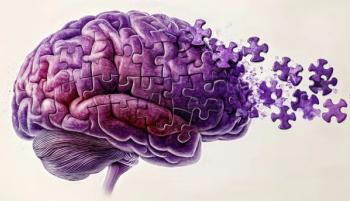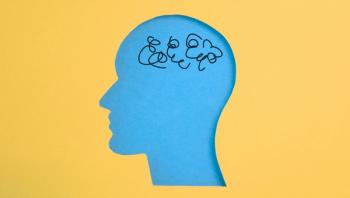
AIDS Dementia: Current Status and New Treatment Approaches
AIDS Dementia: Current Status and New Treatment Approaches
In the long list of morbidities associated with HIV-1 infection, the most common neurodegenerative disorder is HIV-associated dementia (HAD).1 Symptoms are classic signs of cognitive impairment: confusion, forgetfulness, slowed thinking, and poor concentration. Behavioral changes include dysphoria, reduced emotional responsiveness, social withdrawal, and apathy. Psychiatric symptoms resembling those seen in severe psychiatric disorders-severe agitation, delusions, and hallucinations-also emerge in some affected persons. In the later and final stages of HAD, patients often exhibit a vastly diminished reaction to their environment accompanied by neurological deficits that include balance difficulties, leg weakness, and reduced dexterity.2
"We believe that some degree of cognitive impairment is common in people infected with HIV," said Howard Crystal, MD, professor of neurology and pathology at SUNY Downstate Medical College in Brooklyn, New York. "We do not yet know all the factors that contribute to this cognitive impairment, but some of these factors include gender, the severity of the HIV infection, and the nature of the antiretroviral therapy. In evaluating these factors, we must take into account host genetics, viral genetics, premorbid mental ability, substance abuse, psychiatric disorders, and inflammatory markers."
EARLY CNS INVOLVEMENT
As AIDS-associated cognitive impairment became better understood, it became apparent that HAD was not merely the sequela of an opportunistic infection but was the effect of HIV-1 viremia. Accumulated clinical data also revealed CNS involvement even before the development of the usual opportunistic infections and frank AIDS.3 Data from the CDC suggested that CNS complications made up approximately 8% of AIDS-defining diseases,4 whereas an earlier survey involving cohorts from large urban centers concluded that 39% of patients with AIDS or HAD suffered from neurological symptoms and that approximately 10% of patients with AIDS had complaints directly attributable to CNS involvement.5
"Data already collected on the prevalence of cognitive impairment due to HIV infection ranges from none to as high as 50% or 60%, depending on the cohort and the way the study was conducted," Crystal remarked. "How a clinician should treat cognitive impairment when HIV is present is controversial, and no one clear guideline is available."
Most experts in HIV dementia recommend that patients undergo diagnostic imaging, according to Crystal. "If the images are consistent with HIV dementia, then a lumbar puncture should be performed to look for opportunistic infections. This is not terribly controversial. The real issue here is to what extent the HIV virus is in the brain and in the spinal fluid and how that differs with regard to the viremia load. There is no clear-cut answer to this question. Most experts would tell you to use antiretrovirals that get into the brain. However, the direct efficacy of this approach has yet to be proved," Crystal said.
Brain tissue is particularly susceptible to damage caused by immune reactions and infectious disease. The most critical protective structure in the CNS is the blood-brain barrier (BBB). Viruses pass through the BBB by hitching a ride on surveillance macrophages along with lymphocytes and monocytes. This hematogenous route of invasion has been termed the "Trojan horse model of infection of the CNS," and it is believed to be the main mechanism involved in the inva- sion of nervous tissue by HIV-1.6
Psychometric testing of patients with HAD is important. However, the disorder is not readily assayed using the Mini-Mental State Examination unless the patient has frank dementia. If HAD is suspected in a seroconverted patient, the HIV Dementia Scale, the Mental Alteration Test, the Executive Interview, and the HIV Dementia Assessment are useful in establishing a definitive diagnosis. The Memorial Sloan-Kettering Scale, a psychometric tool structured to give a qualitative evaluation of dementia severity, helps in clinical staging by allowing the clinician to follow the progression of HAD.6
CLINICAL PRESENTATION
"HAD usually appears when the CD4+ cell count is less than 200/µL, and that is about 7 to 9 years after initial HIV infection and seroconversion," explained Crystal. "The HIV virus does not attack neurons; it attacks the microglial cells, which are the brain's equivalent of the macrophages or the scavenger cells. However, the presence of the HIV virus does make neurons get sick and die. Many areas of the brain are affected, including the basal ganglia, white matter, and perhaps some brain stem regions, but clearly the neocortex is involved to the extent that if you did a cell count, you would see a 50% decrease in neurons compared with controls. In addition, in the neocortex and the hippocampus, you would see about 90% overall neuron destruction compared with controls."
This neuronal death is referred to as cortical dementia, according to Crystal. Language is relatively well preserved; however, patients often complain of loss of concentration, slowness of thoughts, and forgetfulness.7 In addition to cognitive deficits, approximately 75% of patients demonstrate unsteady gait, about 50% report clumsiness and deteriorating handwriting, and approximately 30% complain of tremor.8
IMAGING AND HAD
Imaging techniques that may be useful in establishing a diagnosis of HAD include CT and MRI.8 Use of single photon emission CT (SPECT), which may be more sensitive than either CT or MRI, often demonstrates multifocal cortical and subcortical areas of hypoper-fusion.9 Positron emission tomography, which demonstrates areas of hypometabolism in the basal ganglia shown to correlate with HAD severity, also has been found useful in establishing a diagnosis.10 Magnetic resonance spectroscopy also has proved useful in identifying reduced levels of N-acetylaspartate, which is a marker of neuronal function in the frontal cortex and basal ganglia.11
"We have found that diffusion tensor imaging techniques, which are not routinely available in most institutions, may be even more sensitive than the MRI. Furthermore, the SPECT scan has been especially useful in identifying those patients in whom a lumbar puncture should be performed every 6 months." Crystal added.
TREATMENT APPROACHES
"No single combination of antiretroviral agents has been shown to improve HAD," remarked Crystal. "Experts in the field always recommend those agents that have the highest CNS penetration. In the case of psychiatric symptoms, such as severe agitation, delusions, and hallucinations, antipsychotic agents such as olanzapine [Zyprexa] and risperidone [Risperdal] have been shown to be effective. In many patients who suffer from depression or apathy, selective serotonergic reuptake inhibitors have been helpful. In my opinion, the use of stimulants such as amphetamines for patients with HAD who exhibit severe apathy may not be helpful."
Treatment for HAD should begin by controlling the underlying infection using HAART. Current HAART regimens are routinely made of 2 nucleoside analog reverse transcriptase inhibitors combined with either a potent protease inhibitor or a nonnucleoside analog reverse transcriptase inhibitor.6
"Improvement of HAD with HAART regimens is inferential and based predominantly on cohort trials in which MRI studies have demonstrated improvement with HAART," explained David M. Simpson, professor of neurology and director of the Clinical Neurophysiology Laboratories and the Neuro-AIDS program at Mount Sinai Medical Center in New York City. "At this point, it would be safe to say that HAART is associated with an overall improvement in AIDS dementia, but if one tries to get placebo-controlled trials as a standard of evidence, there are remarkably few available."
When asked about the future of treatments for HAD, Crystal commented that the only modality that seems to show promise is HAART. Simpson, however, explained that he and his colleagues are in the process of developing new treatments and are engaged in on-going clinical trials.
"The types of treatments that are being pursued fall into 2 main categories. The first category is new antiretroviral therapy. Data to date suggest that the antiretroviral agents that have optimal penetration of the blood-brain barrier are most likely to be the most effective for the treatment of dementia," said Simpson. The second category concerns understanding and attacking "secondary mechanisms beyond direct viral infection that drive dementia," Simpson continued.
Simpson explained that the HIV-1 viral load in the brain is relatively modest in relation to the degree of dementia seen in patients with HIV infection. "In fact, primary neurons are not infected by HIV even though they do degenerate. Secondary mechanisms related to dementia pathogenesis are likely involved," he said. "So there is a large effort being made to study agents that target these secondary mechanisms." Agents that have been studied in placebo-controlled trials include the calcium channel blocker nimodipine (Nimotop), the N-methyl-d-aspartate antagonist memantine (Namenda), the tetracycline antibiotic minocycline, and the monoamine oxidase-B inhibitor selegiline, Simpson explained.
PROGNOSIS
"Before HAART, the prognosis of an HAD diagnosis was 6 to 7 months, after which the patient usually died," commented Crystal. "With HAART, life can now be extended for many months to years."
In terms of risk factors in HIV-infected patients, a low CD4 count is probably the best indicator of progression to HAD, said Crystal. "Other risk factors include coinfection with hepatitis C, intravenous drug use, concomitant diabetes and hypertension, or low cognitive reserve."
References:
REFERENCES
1.
Watkins BA, Klotman ME, Gallo RC. Human immunodeficiency viruses. In: Mandell GL, Bennett JE, Dolin R, eds.
Mandell, Douglas and Bennett's Principles and Practice of Infectious Diseases.
4th ed. Vol II. New York: Churchill Livingstone; 1995:1590-1606.
2.
Mapou RL. Dementia. In: Smith RA, ed.
Encyclopedia of AIDS: A Social, Political, Cultural, and Scientific Record of the HIV Epidemic.
Chicago: Fitzroy Dearborn Publishers; 1998:170-172.
3.
McArthur JC. Neurologic complications of human immunodeficiency virus infection. In: Gorback SL, Bartlett JC, Blacklow NR, eds.
Infectious Diseases.
2nd ed. Philadelphia: WB Saunders Company; 1998:1123-1150.
4.
Centers for Disease Control and Prevention.
HIV/AIDS Surveillance Report 6.
Atlanta: Centers for Disease Control and Prevention; 1994:1-39.
5.
Levy RM, Bredesen DE, Rosenblum ML. Neurological manifestations of the acquired immunodeficiency syndrome (AIDS): experience at UCSF and review of the literature.
J Neurosurg.
1985;62:475-495.
6.
Power C, Noorbakhsh F. Central nervous system viral infections: clinical aspects and pathogenic mechanisms. In: Gilman S, ed.
Neurobiology of Disease.
New York: Elsevier Academic Press; 2007:485-499.
7.
Lipton SA. Memantine prevents HIV coat protein-induced neuronal injuring in vitro.
Neurology.
1992;42:1403-1405.
8.
Brew BJ. AIDS dementia complex. In: Brew BJ, ed.
HIV Neurology.
New York: Oxford University Press; 2001:53-90.
9.
Schielke E, Tatsch K, Pfister HW, et al. Reduced cerebral blood flow in early stages of human immunodeficiency virus infection.
Arch Neurol.
1990;47: 1342-1345.
10.
Rottenberg D, Moeller J, Strother S, et al. The metabolic pathology of the AIDS dementia complex.
Ann Neurol.
1987;22:700-706.
11.
Meyerhoff DJ, MacKay S, Bachman L, et al. Reduced brain
N
-acetylaspartate suggests neuronal loss in cognitively impaired human immunodeficiency virus-seropositive individuals: in vivo H magnetic resonance spectroscopic imaging.
Neurology.
1999;43:509-515.
Newsletter
Receive trusted psychiatric news, expert analysis, and clinical insights — subscribe today to support your practice and your patients.

















